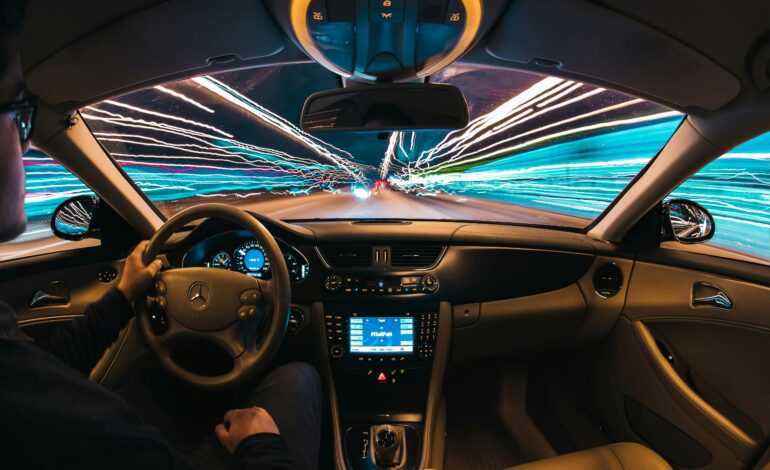6 Ways Technology is Making Driving Smarter and Safer

Technology is rapidly changing every corner of our lives, and cars are no exception. Remember those terrifying car accident statistics?
According to the NHTSA, in 2023 alone, there were still a staggering 40,990 people who died in motor vehicle crashes across the US. While this represents a slight decrease of about 3.6% compared to 2022, thousands of lives are still tragically lost on the road each year, and countless others suffer serious injuries.
Some credit for this decrease can be attributed to technology’s ever-increasing role in car safety. But with so many lives still impacted by accidents, there’s room for even greater improvement. Get ready to explore cutting-edge technologies that could revolutionize car safety and make our roads safer for everyone.
1. Collision Avoidance Systems
Ever feel like you need an extra pair of eyes while driving? Collision avoidance systems (CAS) are here to help. These high-tech systems are like guardian angels on wheels, constantly monitoring your surroundings using a network of cameras, sensors, and radar.
The information gathered by these devices is analyzed by the system’s advanced algorithms. It’s like having a built-in supercomputer constantly scanning for potential dangers. If a collision seems imminent, the CAS takes action.
Forward collision warnings are a common CAS feature. If you’re about to rear-end someone, the system will sound an alarm and flash a warning light to get your attention. Some CAS systems go even further, automatically applying the brakes if the driver doesn’t react in time.
Let us consider the example of an accident-prone city such as St.Louis. According to TorHoerman Law, run-off-road collisions are a major concern in St. Louis, causing a significant number of serious injuries each year.
A recent incident on 7th Jan reported by Riverfront Times exemplifies this issue. A sedan traveling at normal speed through an intersection was struck by a speeding police SUV near its rear wheel. While fortunately, the officers involved sustained only minor injuries, this incident highlights a concerning trend.
This wasn’t an isolated event – it was the third police crash in St. Louis within a short timeframe, underscoring the prevalence of these types of accidents in the city. The fact that the car was hit near its rear wheel suggests a potential issue with the police vehicle’s speed control. It also indicates the driver’s possible lack of awareness of their surroundings.
After such an accident, you might need to consult a local St. Louis personal injury lawyer. St. Louis has many skilled attorneys who can handle your claim, assess damages, and secure fair compensation for medical expenses and other losses.
The St. Louis accident could have been prevented entirely if the police SUV had this technology. With CAS, a warning or automatic braking could have prevented the crash, saving everyone from physical, emotional, and legal burdens.
2. Automatic Emergency Braking
Automatic Emergency Braking (AEB) uses a combination of radar and cameras to act like a guardian angel on the road, constantly monitoring what’s ahead. If AEB detects an imminent crash with another vehicle or obstacle, it takes control by automatically applying the brakes.
The impact of AEB is significant. In many cases, it can significantly reduce the force of a head-on collision, turning a potentially serious accident into a minor fender bender. Even better, AEB can potentially prevent crashes altogether, keeping everyone on the road safe. Additionally, as AEB becomes more common, experts predict a significant decrease in rear-end collisions and related injuries.
The future of AEB is bright, and it’s about to become mandatory. The Washington Post reports that new federal car safety regulations will require all new cars to be equipped with AEB technology by 2029. This includes systems that can detect and avoid pedestrians and other vehicles, even at high speeds.
These regulations are estimated to save an estimated 362 lives per year and significantly reduce the severity of over 24,000 injuries.
3. Lane Change Warning and Lane-Keep Assist
Drifting out of your lane can be dangerous. Lane departure warning systems use cameras to track your position and sound an alarm if you unintentionally leave your lane. Some systems even steer you back into your lane to prevent side collisions and run-off-road accidents, keeping everyone safer.
4. Rear-View Cameras and Parking Assistance
Rear-view cameras, now mandatory in many countries, are a game-changer. These cameras provide a clear view of the area behind your vehicle when reversing. This significantly reduces the risk of backover accidents, especially with pedestrians in crowded parking lots or residential areas.
The market reflects this growing importance. According to Research and Markets, the global automotive backup camera market size reached $2.8 billion in 2023. It is projected to hit $5.2 billion by 2032, with a healthy growth rate of 7.12%. This trend highlights the growing recognition of backup cameras as an essential safety feature.
But technology doesn’t stop there. Advanced parking assistance systems take things a step further. These systems offer real-time guidance and alerts, making even the tightest parking spaces a breeze. Not only do these technologies prevent accidents, but they also take the stress out of parking. This allows you to focus on getting to your destination safely and relaxed.
5. Blind Spot Detection
Driving can be stressful, especially when you’re unsure what’s lurking in your blind spots. Blind spot detection (BSD) takes the guesswork out by using sensors to monitor those hidden areas. BSD uses sensors to monitor hidden areas around your car. When you signal a lane change and a vehicle is there, BSD will warn you with a sound or light, preventing a potential collision.
This technology is particularly valuable on highways with frequent lane changes, offering an extra layer of safety and preventing nasty side-impact accidents.
6. V2X Communication
The future of car safety is connected. Vehicle-to-Everything (V2X) communication allows cars to “talk” to each other and to traffic infrastructure (lights, signs). This real-time information sharing improves driver awareness of hazards (running red lights, sudden braking) and optimizes traffic flow. V2X holds the promise of a safer, more efficient driving experience.
Frequently Asked Questions
Are these safety technologies expensive?
The cost of these technologies varies, but they are becoming increasingly affordable and are often standard features in newer vehicles. Additionally, the potential savings from fewer accidents can offset the initial cost.
Do these systems make me a less attentive driver?
While these technologies are incredibly helpful, they should never be a substitute for safe and attentive driving. Always be aware of your surroundings and remain focused on the road.
Can these systems be hacked or malfunctioned?
Like any technology, there is always a risk of hacking or malfunction. However, manufacturers are constantly working to improve the security and reliability of these systems.
How long will it take for these technologies to be widespread?
Many of these technologies are already available in newer car models. As the cost decreases and regulations evolve, we can expect them to become even more widespread in the coming years.
In conclusion, technological advancements are rapidly transforming our cars into intelligent safety partners. From collision avoidance systems to connected car networks, these innovations hold immense potential to create a smarter future for driving. They also make driving significantly safer for everyone on the road.



